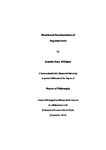Mesofaunal Recolonisation of Degraded Soils
| dc.contributor.supervisor | Blackshaw, Rod | |
| dc.contributor.author | Williams, Jennifer | |
| dc.contributor.other | Faculty of Science and Engineering | en_US |
| dc.date.accessioned | 2013-06-19T08:39:22Z | |
| dc.date.available | 2013-06-19T08:39:22Z | |
| dc.date.issued | 2013 | |
| dc.identifier | 754546 | en_US |
| dc.identifier.uri | http://hdl.handle.net/10026.1/1534 | |
| dc.description.abstract |
The degradation of soil quality due to anthropogenic causes is globally important, both in terms of ecosystem services and ecological biodiversity. Soil quality reduction is stated to be detrimental for population densities and species diversity of soil invertebrates, including the mesofauna (Acari and Collembola). Within the soil food web, mesofauna occupy several trophic levels and as such facilitate nutrient turnover, fulfilling vital ecosystem functions and services. Understanding soil invertebrate population dynamics not only during degradation, but equally upon ecosystem restoration, is vital to identify possible losses or benefits to healthy ecosystem functioning. Prior to this investigation the Highfield site, Rothamsted Research, had been divided and maintained as grassland, arable cropping or bare fallow for 50 years. The latter resulted in a soil that had low soil organic matter levels, poor structure, low bacterial biomass and virtually no invertebrate population. Investigations into the invertebrate population changes, within both the experimental plots and surrounding land, upon alteration of the existing management strategies was completed over a two year period. Changes to mesofaunal populations were detected across all treatments following conversion. Generally, new fallow and arable management strategies produced low density fluctuating populations affected by the physical disturbance of ploughing and lack of soil organic matter as a basal food resource. Grassland management produced increased species diversity and abundance within a more stable soil food web. Each of the new management strategies developed towards its equivalent management strategy within the control treatments. Although it was apparent that the mesofaunal populations were re-establishing under more favourable environmental conditions, there was no definitive conclusion as to the source of the population increases. An attempt to identify the physical mode of invertebrate movement was completed, utilising a prototype mesocosm to act as a physical barrier, this showed promise for future use in such studies. | en_US |
| dc.description.sponsorship | Rothamsted Research | en_US |
| dc.language.iso | en | en_US |
| dc.publisher | University of Plymouth | en_US |
| dc.subject | Mesofauna | en_US |
| dc.subject | Degraded Soils | en_US |
| dc.subject | Acari | en_US |
| dc.subject | Collembola | en_US |
| dc.subject | Mesocosm | en_US |
| dc.subject | Highfield | en_US |
| dc.title | Mesofaunal Recolonisation of Degraded Soils | en_US |
| dc.type | Masters | en_US |
| plymouth.version | Full version | en_US |
Files in this item
This item appears in the following Collection(s)
-
01 Research Theses Main Collection
Research Theses Main


